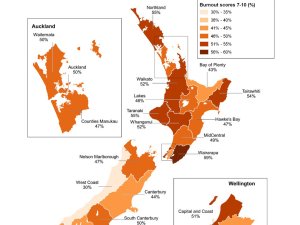Respiratory physician Lutz Beckert considers chronic obstructive pulmonary disease management, including the prevention of COPD, the importance of smoking cessation and pulmonary rehabilitation, and the lifesaving potential of addressing treatable traits. He also discusses the logic of inhaler therapy, moving from single therapy to dual and triple therapy when indicated, as well as other aspects of management
Primary care at critical crossroads: Increase the workforce, fund the workforce
Primary care at critical crossroads: Increase the workforce, fund the workforce

Tim Malloy highlights unwanted statistics from a GenPro survey, which reveals more empty chairs in general practice and subsequent reduced services
We must secure fair pay for family doctor teams. Not just GPs and nurses, but also the broader team
"Winter is coming. We know what is coming with it.” – Jon Snow, Game of Thrones
Despite the well-documented benefits of a strong primary care sector for patients and the wider health system, New Zealand’s family doctor service is at a critical crossroads. It is on the brink and suffering as a result of prolonged and systemic underinvestment and neglect.
The current ED crisis doesn’t look like improving. Winter is coming, we know what is coming with it.
New Zealand has its borders open and arms wide apart to welcome in much-needed tourists and overseas workers. They will also bring their own, and likely invisible, unwanted guests.
The December 2022 Employment Relations Authority interim ruling on the nursing pay equity claim for DHB/ Te Whatu Ora nurses created an increase in the exodus of general practice nurses. But even before then, family doctor services were at serious risk and were being cut in many areas.
GenPro’s survey* of members, carried out between October and December 2022, highlighted some very concerning statistics and trends:
- not accepting new enrolments: 55 per cent of practices
- reduced service levels: 53 per cent of practices
- completely withdrawn some services: 36 per cent of practices.
Of those New Zealanders who are lucky enough to be enrolled, they are often waiting many weeks for an appointment with their family doctor or nurse. Some 45 per cent of patients were waiting more than one week for a GP appointment, with some waiting up to 10 weeks.
The fact that 50 per cent of GPs were planning to retire in the next 10 years is an oft-quoted statistic from the 2020 General Practice Workforce Survey. However, from GenPro’s survey, we now also know that:
- vacancies for an average of 1.8 GPs (average 0.7FTE each): 61 per cent of practices
- had seen a GP leave within the previous three months: 38 per cent of practices
- vacancies for an average 1.6 nurses (average 0.7FTE each): 50 per cent of practices
- had seen at least one nurse leave in the previous three months: 46 per cent of practices.
And remember, these survey results were collated before the pay gap between a general practice nurse and their hospital-employed counterpart had risen to an unbelievable 27 per cent.
And before winter arrived.
We have to believe there is a solution. We have to offer our patients and their whānau some hope.
GenPro has never been more active with the minister, other politicians and officials to help break the impasse. Comprehensive analysis, evidence gathering and weekly representations covering everything from MECA to PSAAP and from workforce supply to maximum retention is currently being deployed to help secure the future of front-line general practice for patients – and for our hospital-sector colleagues who need protecting from the coming onslaught.
The new health minister understands health. The new national director of commissioning for Te Whatu Ora understands general practice. That is a potentially powerfulcombination with whom GenPro is closely engaging.
We must make general practice a career of choice again. The solutions required to do so will come as no surprise. GenPro’s November 2022 publication, On the Brink, sets out our nine-point plan of action which would ensure patients, their whānau and communities could rely on sustainable high-quality family doctor services once again. That publication and action plan is GenPro’s manifesto for election year on behalf of our members. We make no apology for the deliberate repetition.
We must secure fair pay for family doctor teams. Not just GPs and nurses, but also the broader team of essential primary healthcare professionals and kaiāwhina who are consistently working at the top of their scope.
We must increase the workforce. First, by stopping the exodus and retaining the invaluable workforce we currently have. Then, by increasing medical and nursing students, increasing the number of GP registrars, and extending and supporting a much broader family doctor workforce. Think physician assistants, paramedics, pharmacists and all others that think they might only have a partial role.
Finally, we must insist on fair contractual terms and sustainable funding for high-quality essential services that all New Zealanders can rely on. The 45 per cent increase in overall health funding which the Government celebrates, must be channelled to front-line services. Service contracts must become mutually agreed and co-designed rather than the one-sided and imposed contracts of the past. The shift of care from secondary to primary settings, which we all know is the way forward, must be funded transparently and fully.
For general practice to become a career of choice again, New Zealand needs to compete with Australia, Canada, the US, the UK, and all other first-world health systems where personal investment in health infrastructure and services is repaid with fair reward and return.
The crisis within and across New Zealand’s family doctor service has reached a do-or-die moment.
And as any Game of Thrones aficionado would know, what is the one thing that we say to death? Not today.
Tim Malloy is the chair of GenPro - the General Practice Owners Association, and a GP in Wellsford
We're publishing this article as a FREE READ so it is FREE to read and EASY to share more widely. Please support us and the hard work of our journalists by clicking here and subscribing to our publication and website






![Barbara Fountain, editor of New Zealand Doctor Rata Aotearoa, and Paul Hutchison, GP and senior medical clinician at Tāmaki Health [Image: Simon Maude]](/sites/default/files/styles/thumbnail_cropped_100/public/2025-03/Barbara%20Fountain%2C%20editor%20of%20New%20Zealand%20Doctor%20Rata%20Aotearoa%2C%20and%20Paul%20Hutchison%2C%20GP%20and%20senior%20medical%20clinician%20at%20T%C4%81maki%20Health%20CR%20Simon%20Maude.jpg?itok=-HbQ1EYA)
![Lori Peters, NP and advanced health improvement practitioner at Mahitahi Hauora, and Jasper Nacilla, NP at The Terrace Medical Centre in Wellington [Image: Simon Maude]](/sites/default/files/styles/thumbnail_cropped_100/public/2025-03/2.%20Lori%20Peters%2C%20NP%20and%20advanced%20HIP%20at%20Mahitahi%20Hauora%2C%20and%20Jasper%20Nacilla%2C%20NP%20at%20The%20Terrace%20Medical%20Centre%20in%20Wellington%20CR%20Simon%20Maude.jpg?itok=sUfbsSF1)
![Ministry of Social Development health and disability coordinator Liz Williams, regional health advisors Mary Mojel and Larah Takarangi, and health and disability coordinators Rebecca Staunton and Myint Than Htut [Image: Simon Maude]](/sites/default/files/styles/thumbnail_cropped_100/public/2025-03/3.%20Ministry%20of%20Social%20Development%27s%20Liz%20Williams%2C%20Mary%20Mojel%2C%20Larah%20Takarangi%2C%20Rebecca%20Staunton%20and%20Myint%20Than%20Htut%20CR%20Simon%20Maude.jpg?itok=9ceOujzC)
![Locum GP Helen Fisher, with Te Kuiti Medical Centre NP Bridget Woodney [Image: Simon Maude]](/sites/default/files/styles/thumbnail_cropped_100/public/2025-03/4.%20Locum%20GP%20Helen%20Fisher%2C%20with%20Te%20Kuiti%20Medical%20Centre%20NP%20Bridget%20Woodney%20CR%20Simon%20Maude.jpg?itok=TJeODetm)
![Ruby Faulkner, GPEP2, with David Small, GPEP3 from The Doctors Greenmeadows in Napier [Image: Simon Maude]](/sites/default/files/styles/thumbnail_cropped_100/public/2025-03/5.%20Ruby%20Faulkner%2C%20GPEP2%2C%20with%20David%20Small%2C%20GPEP3%20from%20The%20Doctors%20Greenmeadows%20in%20Napier%20CR%20Simon%20Maude.jpg?itok=B0u4wsIs)
![Rochelle Langton and Libby Thomas, marketing advisors at the Medical Protection Society [Image: Simon Maude]](/sites/default/files/styles/thumbnail_cropped_100/public/2025-03/6.%20Rochelle%20Langton%20and%20Libby%20Thomas%2C%20marketing%20advisors%20at%20the%20Medical%20Protection%20Society%20CR%20Simon%20Maude.jpg?itok=r52_Cf74)
![Specialist GP Lucy Gibberd, medical advisor at MPS, and Zara Bolam, urgent-care specialist at The Nest Health Centre in Inglewood [Image: Simon Maude]](/sites/default/files/styles/thumbnail_cropped_100/public/2025-03/7.%20Specialist%20GP%20Lucy%20Gibberd%2C%20medical%20advisor%20at%20MPS%2C%20and%20Zara%20Bolam%2C%20urgent-care%20specialist%20at%20The%20Nest%20Health%20Centre%20in%20Inglewood%20CR%20Simon%20Maude.jpg?itok=z8eVoBU3)
![Olivia Blackmore and Trudee Sharp, NPs at Gore Health Centre, and Gaylene Hastie, NP at Queenstown Medical Centre [Image: Simon Maude]](/sites/default/files/styles/thumbnail_cropped_100/public/2025-03/8.%20Olivia%20Blackmore%20and%20Trudee%20Sharp%2C%20NPs%20at%20Gore%20Health%20Centre%2C%20and%20Gaylene%20Hastie%2C%20NP%20at%20Queenstown%20Medical%20Centre%20CR%20Simon%20Maude.jpg?itok=Z6u9d0XH)
![Mary Toloa, specialist GP at Porirua and Union Community Health Service in Wellington, Mara Coler, clinical pharmacist at Tū Ora Compass Health, and Bhavna Mistry, specialist GP at Porirua and Union Community Health Service [Image: Simon Maude]](/sites/default/files/styles/thumbnail_cropped_100/public/2025-03/9.%20Mary%20Toloa%2C%20Porirua%20and%20Union%20Community%20Health%20Service%20in%20Wellington%2C%20Mara%20Coler%2C%20T%C5%AB%20Ora%20Compass%20Health%2C%20and%20Bhavna%20Mistry%2C%20PUCHS%20CR%20Simon%20Maude.jpg?itok=kpChr0cc)